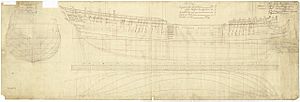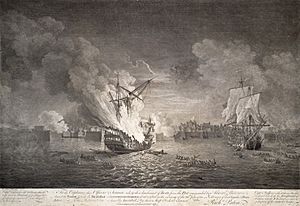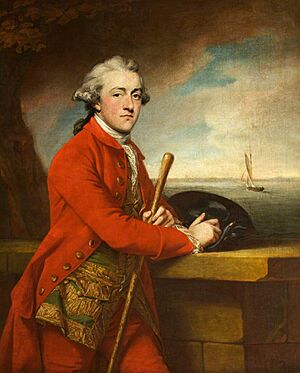HMS Scarborough (1756) facts for kids
HMS Scarborough was a brave sailing ship from the 1700s. She was built in 1756 for the Royal Navy, which is Great Britain's navy. This ship had 20 guns and a crew of about 160 sailors. For many years, she sailed the seas, helping to protect British interests around the world.
Quick facts for kids History |
|
|---|---|
| Name | HMS Scarborough |
| Ordered | June 1755 |
| Builder | Blaydes Yard in Kingston-Upon-Hull |
| Laid down | August 1755 |
| Launched | April 1756 |
| Fate | sank 5 October 1780 during the Great Hurricane of 1780 off San Domingo in the Caribbean with all hands. |
| General characteristics | |
| Class and type | 22-gun 6th rate |
| Sail plan | Full-rigged ship |
Contents
The Story of HMS Scarborough
Building a Mighty Ship
The idea for HMS Scarborough came about in June 1755. She was built at a place called Blaydes Yard in Kingston-Upon-Hull, England. It took about nine months to build her. She was designed by a famous ship designer named Sir Thomas Slade. In April 1756, the ship was ready and launched into the water. Captain Robert Routh was her first commander.
Adventures in North America
In September 1757, HMS Scarborough sailed across the Atlantic Ocean to North America. This was during a big conflict known as the Seven Years' War. In May 1758, she successfully captured an American ship named Echo near Louisburg. Soon after, in June, she played a part in the Siege of Louisburg. This was a major battle to take control of an important fort.
The next year, in 1759, HMS Scarborough was sent to Quebec. There, she joined the Battle of Quebec under the command of Captain John Stott. This battle was a very important moment in the war.
In 1760, the ship returned to Louisburg. Then, she sailed north to Newfoundland. On July 8, she took part in the Battle of Chaleur Bay. In this battle, four British ships, including Scarborough, defeated three French ships. Captain Stott was still in command.
Protecting the Colonies
After her adventures, HMS Scarborough returned to England for a few years. In August 1762, she sailed back to America and the Leeward Islands. These islands are in the Caribbean Sea.
In 1765, the ship received a big upgrade at Deptford. She was put back into service in November 1766. Captain Robert Gregory then took her to the Leeward Islands in April 1767, where she stayed until 1769.
After a period of rest, the ship had another major refit at Chatham Docks. She was ready to sail again in June 1774. Captain James Chads took command and sailed her to Boston. This was right after the famous Boston Tea Party, a protest where colonists threw tea into the harbor.
In October 1774, Captain Andrew Barkley took command and sailed her back to England. But she didn't stay long! Later that same October, she left Plymouth with important messages for Boston. She arrived on December 3. The crew even hosted the governor, John Wentworth, for New Year's Eve celebrations.
HMS Scarborough stayed in America until 1779. During this time, she was involved in events related to the American Revolutionary War. She captured several ships, including "St. Barbary" and "McPherson" off New England. She also recaptured a ship called "Generous Friend." In October 1777, she captured "Beverly" near Nova Scotia. She also captured a schooner named "Lucy" on the Grand Banks.
In April 1779, the ship was taken out of active service for a while. She received a special copper bottom at Chatham. This upgrade cost more than the ship's original building price!
Final Voyage
On May 22, 1780, HMS Scarborough set sail for the Leeward Islands once more. Captain Robert Boyle Nicholas was in command.
In August 1780, Captain Samuel Hood Walker took over as commander. Sadly, on October 5, 1780, HMS Scarborough faced a terrible storm. This was the Great Hurricane of 1780, one of the strongest hurricanes ever recorded. The ship sank off San Domingo in the Caribbean Sea, and everyone on board was lost.




